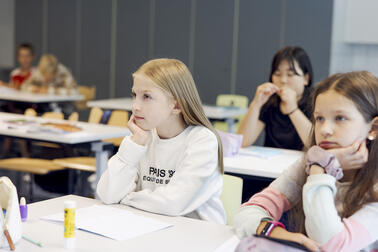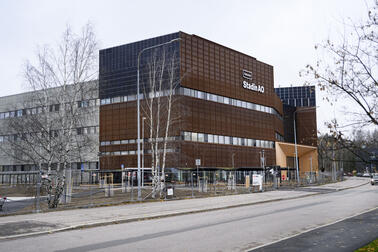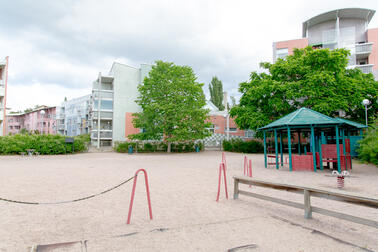The public Swedish-language general upper secondary schools in Helsinki have worked to develop the S2 subject (Swedish as a second language). The schools launched a preparatory course leading up to the matriculation exams and have come up with practical day-to-day solutions for the S2 students.
"We have worked for better exposure for the S2 studies and have formed a shared vision on how we can work towards the same goals in the City. We now have a good foundation for it, and the wheel does not need to be reinvented every time", Ilse Fabritius, teacher at Tölö Gymnasium Upper Secondary School, says.
Fabritius and Jacob Töringe, a colleague from the Lärkan Upper Secondary School, talked about the development work at LUKE, the development network of the general upper secondary schools, and its seminar at Hakaniemenranta's government agency building on Thursday, 10 April, 2025.
Models for assessment and differentiation of schoolwork
The work has been carried out as part of the City of Helsinki's general upper secondary education's quality and accessibility project, financed by the National Board of Education.
"The project gave us the readiness to work with this topic. It gave us time to work on assessment and creating differentiation data. Something that has, unfortunately, easily been given zero priority before", Jacob Töringe says.
He mentions the digital teaching platform Google Classroom as a good tool for differentiating the students' schoolwork.
One important result has been that a S2 student goes through general upper secondary education with the same subject teacher.
A small but growing number of students
During the process, Fabritius and Töringe discussed reguraly with the Matriculation Examination Board and heard about the experinces in the Ostrobothnia region, where the proportion of S2 students at Kristinestad city’s general secondary school is somewhat greater.
In the Swedish-language general upper secondary school in Finland, the S2 exam was taken by 15 students in spring 2024, a number that had grown in just a few years.
"Our schools in Helsinki, considered in terms of the Swedish-speaking population, are large, but the size of the sample is small. Two S2 students can have quite different preconditions, as is the case in any subject. However, if we should have something that worked with two students during one academic year, the same may not work the next year with two totally different students. Nevertheless, we have worked on making it succeed", Fabritius says.
Teachers against stigmatisation
The teachers would like to see more students who have the right to study the S2 subject start the S2 studies. At the same time, they wish to reduce the stigma that, to some degree, surrounds the subject.
"Jan Hellgren of the Matriculation Examination Board suggested to use the same material for the whole group in groups that have both S1 and S2 students. Moreover, this is also an efficient use of time for the teacher. We work in parallel, look up difficult words, the teacher reads out loud, allowing everyone to keep up – and these methods benefit both S1 and S2 students", Ilse Fabritius notes.
According to the teachers, to reach out to potential S2 students it is possible to use questionnaires when a student accepts a student place or make observations during the first mother tongue classes.
Based on the matriculation exam, preparatory course material has been developed consisting of study tips, model answers and a bingo card to use everyday Swedish.
"S2 is as valuable as S1, Swedish as mother tongue, and gives the same points when applying for a student place", Jacob Töringe points out.
The results from the general upper secondary education's quality and accessibility project will be published in May 2025. The development trials in the schools have touched upon various themes, such as co-teaching, students' well-being and participation.
The material from the Swedish-language general upper secondary schools is being published in a separate Swedish-language publication and in a general bilingual publication, where the Finnish-language general upper secondary schools in Helsinki City's development trials are included.
The publications are released on the aoe.fi platform, which is an electronic library for open teaching materials.


